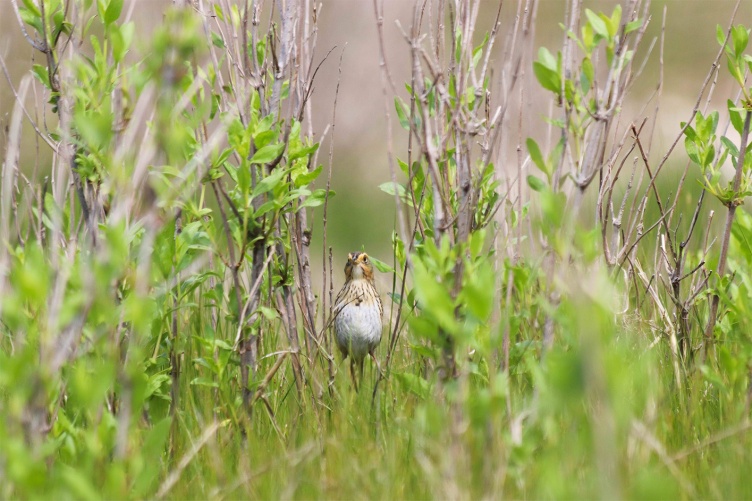Key Research Finding
The genetic diversity of saltmarsh sparrow populations is impacted by geographical distance, environmental factors and landscape features, highlighting the importance of protecting diverse marsh types—including inland, coastal and urban—across the range of the species to preserve its genetic and ecological diversity. The study also raised considerations about the resilience of saltmarsh sparrow populations, emphasizing the need for long-term conservation efforts.
Factors Influencing Saltmarsh Sparrow Genetic Diversity
The saltmarsh sparrow (Ammospiza caudacuta) lives along the northeastern Atlantic coast of the United States, specifically in tidal salt marshes, from Maine to Virginia. They are one of just a few vertebrates adapted to living in the harsh conditions of coastal salt marshes. Female saltmarsh sparrows will nest in higher marsh areas to protect their nests from flooding during high tides. Read more
Saltmarsh sparrows are a declining species, due to habitat degradation, loss and fragmentation. They are particularly vulnerable to climate change, as rising sea levels are increasing the rates of flooding of their nests. Over the past decade, the saltmarsh sparrow population declined by 9% each year due to human activities like development, modifications to marshes and rising sea levels. As a result, the species is at risk of extinction by 2060 and is currently classified as globally endangered under the IUCN Red List and is undergoing assessment for potential listing under the U.S. Endangered Species Act.
Key Terms
Genetic divergence: Expand for definition
Over time, populations and species accumulate genetic differences that make them distinct from each other. These differences can occur due to genetic mutations, natural selection, random changes in alleles, and limited breeding among populations. As a result, populations can become isolated from one another and may lose genetic diversity. Over evolutionary time, they may develop unique traits and genetic compositions, potentially leading to the formation of new species or separate groups within a species.
Genetic diversity): Expand for definition
Refers to the variety and variability of alleles within a population or species, influencing their adaptability and ability to respond to environmental changes and threats.
Interspecific hybridization: Expand for definition
Interbreeding of two distinct species resulting in the production of genetically intermediate offspring.
Isolation-by-distance: Expand for definition
Genetic differences among populations increase as the geographic distance among them gets larger, such that genetic similarity decreases with greater distance.
Isolation-by-environment: Expand for definition
Genetic differences among populations changes because of their distinct affinity for or adaptation to specific ecological conditions, indicating that populations in different environments will differ.
Isolation-by-resistance: Expand for definition
Genetic differences among populations form because of barriers or obstacles present in the physical landscape, such as roadways, bodies of water, or human development.
Microsatellite genotyping: Expand for definition
A method of analyzing DNA that can be used to identify individuals and study the genetic structure of populations. Microsatellites are short, repeating sequences of DNA that are found throughout the genome; identifying them allows researchers to distinguish among individuals, even closely related individuals.
Population resilience: Expand for definition
The ability of a population to withstand and recover from various challenges or disturbances, such as environmental changes or threats to their survival, indicating their capacity to bounce back and maintain stable numbers over time.
Indicator species are crucial for determining and monitoring ecosystem health, as they alert scientists to potential dangers facing an environment. The saltmarsh sparrow (Ammospiza caudacuta) is one such species, inhabiting tidal salt marshes along the northeastern coast from Maine to Virginia. Alarmingly, this species has seen a decline of 9% per year over the past decade, with projections suggesting possible extinction by 2050. This decline is a potentially foreboding indicator of the fragile resilience of coastal salt marshes, along with their vital and diverse ecosystems that support thousands of organisms. A recent collaborative study, involving University of New Hampshire scientists from the New Hampshire Agricultural Experiment Station (NHAES), has been pivotal. By integrating population surveys and genetic analyses of the saltmarsh sparrow, this research offers essential insights for the conservation of this species. Additionally, it underscores the broader significance of genetic monitoring in establishing conservation priorities for endangered wildlife species.
The research, which was recently published in Ornithological Applications, included input from scientists from Cornell University, the University of Connecticut, State University of New York, the University of Maine and the University of Delaware, as well as the U.S. Fish and Wildlife Service and the Maine Department of Inland Fisheries and Wildlife. NHAES scientist Adrienne Kovach, who has examined conservation efforts for the saltmarsh sparrow for 15 years, led the effort.
“The saltmarsh sparrow is one of only a few vertebrate species, mostly birds, that are adapted to living in the tidal salt marsh ecosystem,” said Kovach. “As such, they are a unique component of the earth’s biodiversity.”
“The goals of this study were to characterize genetic variation in saltmarsh sparrow populations across the Northeast,” Kovach added. “This included investigating both the genetic diversity within many different marsh locations; that is, the diversity of the gene pools of these populations and genetic differentiation among the marsh locations as an indication of population structure.”
Examining Saltmarsh Sparrow Genetic Diversity
To understand the genetic structure of the saltmarsh sparrow, researchers collected a total of 964 bird samples from 24 marshes from 2007 to 2015. Sampled marshes were in Connecticut, Maine, Massachusetts, New Hampshire, New Jersey, New York and Rhode Island, which represent habitats of approximately 60% of the global breeding range for saltmarsh sparrows. The researchers used a method called microsatellite genotyping to gain insights about the species' genetic diversity and how populations were structured across their breeding range.
“The goals of this study were to characterize genetic variation in saltmarsh sparrow populations across the Northeast...This included investigating both the genetic diversity within many different marsh locations; that is, the diversity of the gene pools of these populations and genetic differentiation among the marsh locations as an indication of population structure.” ~ Adrienne Kovach, associate professor of Natural Resources and the Environment
Ultimately, the researchers found that saltmarsh sparrow populations are genetically differentiated based on their geographic proximity, a concept known as “isolation-by-distance,” because birds interbreed among marshes within a range of 70 to 85 miles. Two other factors, “isolation-by-resistance” and “isolation-by-environment,” also shape genetic differences in the species. Human development around marshes can isolate breeding areas, reducing genetic diversity, while preserving marshland and high-quality habitats promotes genetic diversity and reduces differences among populations. Additionally, sparrows in marshes located further inland from the Atlantic Ocean have more genetic differences compared to coastal ones.
Jennifer Walsh ’07 ’09G ’15G, a researcher in the Cornell Lab of Ornithology, said that genetic diversity is often viewed as a building block for evolutionary change and adaptation. Therefore, in rapidly changing environments, such as salt marshes, preserving genetic diversity might result in a higher population resilience by a species over time. For example, in northern marshes, the saltmarsh sparrow interbreeds with another species, Nelson’s sparrow (Ammodramus nelsoni). This interbreeding increases genetic diversity within the saltmarsh sparrow population but also creates higher differences among marshes with a lot of hybridization.
“Hybridization can have a range of complex outcomes—from negative effects such as ‘swamping’ of species’ gene pools to beneficial impacts such as bolstering genetic diversity through gene flow—which is why it is such an important topic in conservation and species management,” described Walsh. “It is hard to say definitively whether hybridization is good or bad, as it is very context dependent, however, studying dynamics between hybridizing species is a critical step towards successful management and the fostering of informed conservation initiatives.”
In the case of the saltmarsh sparrow, hybridization with Nelson’s sparrow may have negative impacts on the fitness of saltmarsh sparrows, said Kovach.
“But these consequences are minimal compared to the severe negative impacts of sea-level rise, so conserving hybrids is warranted along with pure individuals,” Kovach added.
Conserving the Saltmarsh Sparrow

NHAES scientist Adrienne Kovach (top left) along with alum Margaret Yates '23 (lower left) and UNH graduate student Talia Kuras. Image courtesy of UNH Marketing
To protect the saltmarsh sparrow's genetic diversity and ensure that a sufficient population remains, conservation efforts should focus on preserving the breadth of different types of marshes across the species’ range, including those in inland, coastal and urban areas, as they contribute important diversity to the species gene pool.
It's also important to connect these populations at a regional level. By protecting high-quality marsh habitats within approximately 80 miles, conservationists can encourage the exchange of genes among different groups. Creating “stepping stone” populations throughout their range is also crucial to keep the saltmarsh sparrow populations well connected and thereby interbreeding and maintaining genetic diversity.
“Ultimately the fate of saltmarsh sparrows depends on our ability to maintain high elevation marshes where they can successfully breed,” said Chris Elphick, an associate professor of ecology and evolutionary biology at the University of Connecticut. “Even if we manage to maintain habitat though, the population is likely to continue to decline and to be smaller in the future.”
And, as the population shrinks, the loss of genetic variation will increasingly become an additional threat to the future of the saltmarsh sparrow.
“Understanding patterns of genetic variation now is, therefore, likely to be very important to decisions—such as listing the saltmarsh sparrow on the U.S. Endangered Species Act—and about where to prioritize future conservation actions,” added Elphick.
This material is based on work supported by the NH Agricultural Experiment Station through joint funding from the USDA National Institute of Food and Agriculture (under Hatch award number 1006964) and the state of New Hampshire. Additional funding was provided by a Competitive State Wildlife Grant (U2-5-R-1) via the United States Fish and Wildlife Service, Federal Aid in Sportfish and Wildlife Restoration to the states of Delaware, Maryland, Connecticut, and Maine; the United States Fish and Wildlife Service (Region 5, Division of Natural Resources, National Wildlife Refuge System); the New York Department of Environmental Conservation (AM08634); the USDA National Institute of Food and Agriculture, project number #ME0-H-6-00492-12; and the National Science Foundation #1826777. Graduate students were also funded in part by the National Science Foundation, the National Park Service Gateway Learning Center Fellowship, the University of Maine, the University of New Hampshire and the University of Connecticut.
This work is co-authored by Jennifer Walsh, Lindsey Fenderson, Chris Elphick, Jonathan Cohen, Christopher Field, Laura Garey, Thomas Hodgeman, Alison Kocek, Rebecca Longenecker, Kathleen O’Brien, Brian Olsen, Katharine Ruskin, W. Gregory Shriver and Adrienne Kovach.
You can read the published article, Surrounding landscape, habitat and hybridization dynamics drive population structure and genetic diversity in the Saltmarsh Sparrow, in Ornithological Applications.
-
Written By:
Nicholas Gosling '06 | COLSA/NH Agricultural Experiment Station | nicholas.gosling@unh.edu



























































